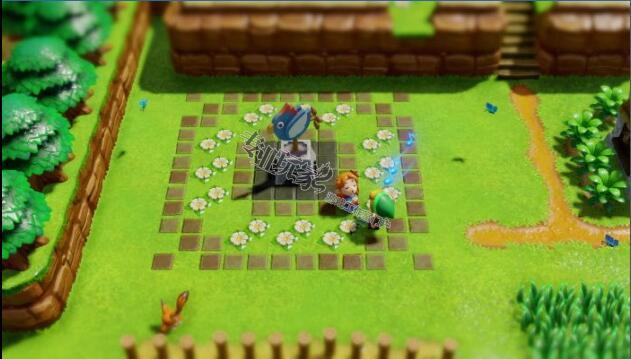RPG文件:Link的觉醒让我想起了Hyrule中强大的音乐力量
2019-09-24
752

最近有一句熟悉的话:《林克的觉醒》是我玩过的第一款塞尔达游戏之一,但它却给我留下了如此深刻的印象,并影响了我对此后每一款塞尔达游戏的看法。具体来说,塞尔达系列是如何对待音乐的。
《塞尔达传说》不仅有振奋人心的主题曲,而且在过去的三十年里,游戏玩家和粉丝们一直在翻唱这首歌。这是少数几首超越游戏的歌曲之一,就像大多数人即使没有玩过马里奥游戏也能唱出马里奥主题一样。这些振奋人心的音符能让任何人热血沸腾。
但自从我在90年代举家搬到拉斯维加斯的一次公路旅行中遇到科霍林特岛(Koholint)以来,有一首歌一直萦绕在我的脑海。《风鱼之歌》(the Ballad of the Wind Fish)蜷缩在我的游戏男孩(Game Boy)的屏幕前,是那部电影的配乐。我认为看到音乐在冒险游戏中扮演核心角色是一件非常有趣的事情——这也是该系列游戏一直在做的事情。

林克觉醒的核心任务是收集警报器,唤醒风鱼。这个想法,乐器是解锁的关键比赛结束对我是那么的酷,特别是当我还是希望我的父母会给我买一个萨克斯管演奏我到中学时(提示:他们所做的——我仍然玩二十年后)。因此,在我小时候玩塞尔达系列的时候,一个主题就开始渗透进来,那就是音乐有力量。
我是《指环王》的铁杆粉丝(我的推特账号是LOTRLore是有原因的)。音乐在第二世界的力量被编织进了托尔金的创作中——这个世界实际上是通过阿努尔人的音乐创造出来的。就像阿尔达一样,音乐本身的力量也编织在海拉尔的肌理中——或者在林克的觉醒中,编织在科霍林岛的肌理中。《塞尔达传说》系列展现了音乐唤醒传奇生物、引发风暴或让时间倒流的力量。
我会发现自己走在Nellis AFB的新房子周围,哼唱着Marin的风鱼民谣。事实上,当链接的唤醒开关宣布时,我只需要听到那三个上升的音符,就知道我会再次被重拍吸引。这首歌曾一度是我童年的歌。
这不仅仅是音乐作为一种情节装置的使用方式——《野性的呼吸》中钢琴主题的微妙变化可以告诉你你周围发生了什么。超世界主题在一个链接到过去是字面上的系列主题-一些林克的觉醒也在一定程度上做了,虽然在最新版本的开始多了一点单簧管。
这些可识别的主题奠定了游戏和其他系列的基础,将它们彼此连接起来——但不仅仅是音乐本身,还有与音乐的联系。在林克的觉醒中,他正在收集塞壬的工具。在《时间的陶笛》中,他使用同名的陶笛可以引发风暴,改变一天的时间。《时间之歌》从打开时间之门开始,一直延续到各个时代,赋予了林克穿越时空的力量,让我们回到《玛君拉的面具》的第一天,你甚至能在《野性的呼吸》中听到它的主题。

在Windwaker Link中,不仅仅是演奏音乐的一部分——当他拿着Windwaker指挥棒时,他在创作音乐。
上周Switch发行后,我一直在玩《Link 's Awakening》,这款游戏让我想起了所有这些主题,并在不同的游戏中进行了回顾。这让我想起了塞尔达系列的根基不仅在于它出色的主题,还在于故事本身与音乐本身的联系。它在几乎每一款塞尔达游戏中都扮演着积极的角色。《风之鱼》的民谣就像《塞尔达传说》系列之后的每首歌一样,拥有强大的力量。我希望随着《塞尔达传说》系列进入第三个十年,这一趋势能继续下去。
专业玩家网是一个专业的游戏工作室门户网站,游戏工作室可以在这里获得最新的游戏工作室资讯,最新游戏工作室项目,最专业的游戏工作室防封方法,人气游戏工作室论坛,是游戏工作室首选并且值得珍藏的网站!
原文:
Here’s a familiar sentence as of late: Link’s Awakening was one of the first Zelda games I ever played – yet it’s one that formed such a lasting impression it’s influenced how I’ve looked at every Zelda game since. Specifically, how the Zelda series treats music.
It’s not just that The Legend of Zelda series has rousing title music that is sung over and over throughout the last three decades by gamers and fans alike. It’s one of the few songs that transcend gaming, much like most people can sing the Mario theme even if they haven’t played a Mario game. Those rousing notes can get anyone’s blood pumping.
But one song has always stuck with me since I tackled the island of Koholint on a road trip as my family moved to Las Vegas back in the 90s. Huddled around the screen of my Game Boy, the Ballad of the Wind Fish was the soundtrack of that car ride. I thought it was so interesting to see music play a central role in an adventure game – something the series has always done.
Link’s Awakening’s core mission is to gather the Instrument of the Sirens and to wake the Wind Fish. This idea that musical instruments were the key to unlocking the end of the game was something so cool to me, especially as I was still hoping my parents would buy me a Saxophone to play when I got to Middle School (spoiler alert: they did – I still play twenty years later). As a result, a theme that started to permeate early on as I played the Zelda series growing up was that music had power.
I’m a huge Lord of the Rings nut (my Twitter handle is LOTRLore for good reason). The power of music in that secondary world is woven into the fabric of Tolkien’s creation – the world was literally created through the Music of the Ainur. Just like Arda, the power of music itself is woven into the fabric of Hyrule - or in Link's Awakening's case, Koholint Island. The Zelda series showcases the music has the power to wake legendary creatures, start storms, or turn back time.
I would find myself walking around out new house on Nellis AFB humming Marin’s Wind Fish ballad. In fact, when the Link’s Awakening Switch announcement was made, those three ascending notes were all I needed to hear to know I would be hooked again on the remake. It literally was the song of my childhood for a time.
It’s not just the way music is used as a plot device either – the subtle changes in the piano motifs in Breath of the Wild tell you a lot about what is going on around you. The overworld theme in A Link to the Past is literally the series theme – something Link’s Awakening also does to an extent, though albeit with a bit more clarinet at the outset in the latest version.
These recognizable themes ground the game with the rest of the series, connecting them with each other – but not just the music itself but Link’s connection with the music. In Link’s Awakening he is gathering the Siren’s Instruments. In Ocarina of Time his use of the eponymous Ocarina can start storms, change the time of day. The Song of Time finds its way from opening the Door of Time and down through the ages, giving Link the power to warp back to the first day in Majora’s Mask, and you even hear the leitmotif in Breath of the Wild some.
In Windwaker Link isn’t just playing a part of the music – as he holds the Wind Waker conductor’s baton, he’s creating the music.
As I’ve been playing through Link’s Awakening on the heels of the Switch release last week, I’m reminded of all these themes and call backs across the different games. I’m reminded how rooted the Zelda series is not just in its excellent theme, but the stories themselves are tied to the music itself. It plays an active role in virtually every Zelda game. The Ballad of the Wind Fish holds power like every song to come after in the Zelda series, and it’s a trend I hope we see continue as the series moves through its third decade.
免责声明:部分内容转自其他媒体,转载目的在于为游戏工作室传递更多信息,如因作品内容、版权和其他问题请 联系客服